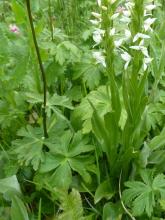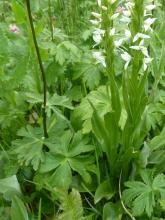Well, the plant I have shown previously on this forum as "Aconitum anthoroideum" definitely isn't, when I compare it to the eFlora of China illustration and description of the species.
My plant is a little over 6 feet tall in bloom, and is a bit lax (though I don't suppose it is a climbing variety, but have no experience with those).
The leaves, and especially, flower shape, bear no resemblance to what it was said to be:


Here is the eFlora of China info for Aconitum anthoroideum:
http://www.efloras.org/florataxon.aspx?flora_id=2&taxon_id=200007107
http://www.efloras.org/object_page.aspx?object_id=39610&flora_id=2
I'm grinding through the Chinese Aconitum key to see if I can find it (assuming it's Chinese?), but if someone recognizes it, please let me know!
Comments
Re: Unknown Aconitum
My best guess is Aconitum umbrosum. Although, the two species following in the key are also very close. A ruler next to key parts would be very helpful.
This guess will help point you in the right direction. A definitive id really cannot be obtain without a specimen in hand. Especially, considering the obscurity of the source relative to my familiarity with Eastern and Midwestern United States Flora.
James
Re: Unknown Aconitum
The leaf "spotting" is really quite attractive.
The placing of the leaf blotches at the base of every acute angle of the leaf edge intrigues me.
What would/could cause such pattern?
Has anyone seen this on other plants?
Re: Unknown Aconitum
Thanks for the guess, James.
The leaf "spotting" is really quite attractive.
What would/could cause such pattern?
Has anyone seen this on other plants?
I was actually wondering that myself. Trollius albiflorus/laxus shows the same sort of feature, which makes them recognizable at a glance:
I'll have to remember to look at both closely next year to see if I can tell what causes it.


Beautiful foliage on your plant, but you're right, the foliage of the species in FOC is completely different. There's only 211 Aconitum species in China, should be a snap ;)